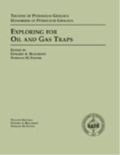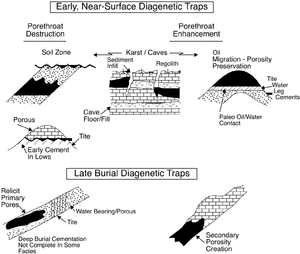Types of diagenetic traps
Jump to navigation
Jump to search
| Exploring for Oil and Gas Traps | |

| |
| Series | Treatise in Petroleum Geology |
|---|---|
| Part | Predicting the occurrence of oil and gas traps |
| Chapter | Exploring for stratigraphic traps |
| Author | John C. Dolson, Mike S. Bahorich, Rick C. Tobin, Edward A. Beaumont, Louis J. Terlikoski, Michael L. Hendricks |
| Link | Web page |
| Store | AAPG Store |
Diagenetic traps are created by pore throat modifications of primary facies. They can also be created by changes in fluid type within the pore system.
Categories
Diagenetic traps occur in two basic categories: early or near-surface traps and late-burial traps.
Early or near-surface diagenetic traps are created by the following:
- Reservoir destroyed by paleosols, meteoric cementation, karsting, cave development, and/or sediment infill
- Reservoir enhanced by paleo-groundwater movement and/or karsting
Late burial diagenetic traps are created by the following:
- Bottom seal generated below oil-water contacts by late cementation
- Primary porosity preserved due to selective cementation and/or early hydrocarbon emplacement
- Secondary porosity created by cement and/or matrix dissolution
Figure 1 shows cross sections of diagenetic trap types.
See also
- Diagenetic traps: criteria for recognition
- Diagenesis: information from petrology
- Diagenetic trap regime
